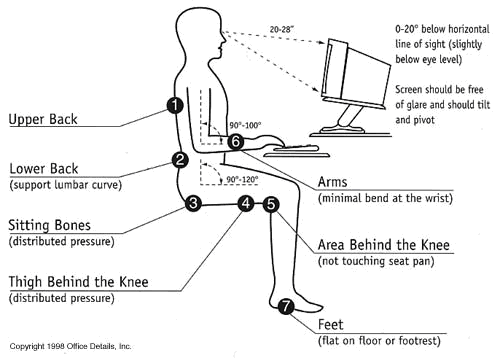Office Ergonomics – Why it’s important?
Did you know that desk jobs can be hazardous to our health? At first the thought sounds silly, but it is common for people to experience injuries in the workplace, and it does happen. This is where ergonomics comes into play. Ergonomics is the study of the environment you work in, the work you do, the tools used to get the job done, and the efficiency of the work produced. The main purpose of office ergonomics is to ensure that your work space is setup in the most efficient way to allow you to provide the best results in your work as well as maintain good heath.
Office chair related injuries are considered non-accidental back injuries. Although back injury is most common, other issues that people experience are headaches, eyestrain, and neck pain which result from doing repetitive tasks throughout the day. Bad posture, lifting heavy objects, and falls also contribute to injuries in the workplace. These injuries can cause stress and strain on our bodies including: muscles, nerves, tendons, joints, blood vessels, and spine. Most often people experience pain in their back, hands, and wrists, which can cause fatigue and contribute to long term health issues if these issues are not acknowledged and treated in the right manner.
Office ergonomics ultimately can lower stress and allow productivity which produces better results. Main focuses would be the setup of your workstation, how you sit and how long you sit in that position, the types of movements you make, and how often these movements are made. Lighting, room temperature, and noise all contribute to the environment we work in.
Tips for Good Health
1) Fix your posture
It is crucial for spine heath to maintain the ideal sitting posture, which requires that arms are parallel to the spine, with elbows and knees bent at 90 degree angles. Be conscious in correcting yourself until good posture become a habit.
2) Adjust your seat
Did you know that sitting in a chair that is too high can increase the risks for ankle swelling? People with circulation issues can experience swelling more frequently than others. Suitable seat height is considered 16 to 21 inches.
3) Raise your feet
Using a footstool reduces pressure on feet, decreasing the foot pain at the end of the day. Try to avoid leaving them hanging all day long.
4) Support your back
Back support is essential in preventing slouching and minimizing the load on your back. The ideal office chair is between 12 and 19 inches wide. Make an effort to press your bottom against the back of the chair to avoid slouching, which can reduce the amount of stress on the lumbar discs and other structures of the lower back.
5) Use the armrests
Armrests play an important role in reducing neck and shoulder strain. They provide the proper support which reduces the preferred position of leaning forward and slouching in front of the screen. With the proper support, armrests are necessary to reduce strain off the shoulders and neck. These are all important things to consider when purchasing an office chair. Make sure the chair meets all of your physical needs.
Remember that we want to avoid prolonged static posture because the body can only tolerate one position for about 20 minutes, which is why sitting at your desk can be detrimental to your health. It is important to consider other options to avoid any unhealthy consequences. Even simple changes in position, or short walks to avoid any long-term position. Take breaks throughout the day and stretch, change tasks, and be sure not to put excessive stress on one particular area of the body. Not only do these rules apply while at the office, but also throughout casual activities such as driving, standing, etc. Live healthy, live happy, and practice good spine heath by following these ergonomic tips today!






